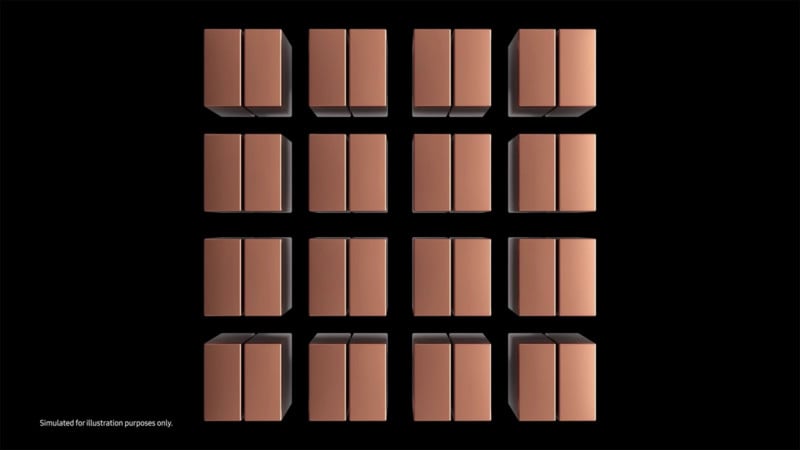Samsung has announced the next generation of its 50-megapixel sensor called ISOCELL GN2. It follows last year’s GN1 and promises significant autofocus improvements thanks to a new phase-detection advancement the company calls “Dual Pixel Pro.”
Dual Pixel is a technology most commonly associated with Canon cameras and splits a pixel to allow it to sense a phase change on a per-pixel basis rather than relying on interspersed phase detection pixels on the sensor which results in the loss of image quality since those pixels aren’t being used to capture image data.
As Canon explains it:
Samsung says that the concept is similar to how human eyes work. Each eye sees slightly different versions of the same scene and focuses by comparing those two differences and finding the mean. Just like that, phase detection works by comparing the phase differences in images generated by left-looking and right-looking pixels, which allows the camera to calculate the focus distance or the place where the two phases align.

Previous Dual Pixel Arrangement
With this first-generation Dual Pixel autofocus, the pixel was split down the middle. In Dual Pixel Pro, that split is shifted diagonally so that not only can pixels see phase differences between the left and right side of a pixel, but also top and bottom.
“Dual Pixel Pro takes autofocus to a new level,” Samsung writes. “It uses green pixels that divide photodiodes with diagonal structure. These diagonally-split pixels compare the phase differences between the top and bottom of the pixel in addition to phase differences in the left and right sides.”

Samsung Dual Pixel Pro
The result is a sensor that has fast and accurate autofocus in more conditions. Samsung says this arrangement makes focusing in low light or on fast-moving subjects even more reliable and addresses the limitations of the original Dual Pixel technology.
“Dual Pixel technology… struggles to differentiate between the left and right sides of patterns such as parallel horizontal stripes,” Samsung explains. “The addition of top and bottom phase detection means your camera can better distinguish these patterns, making it capable of quickly grabbing focus even when your subject is wearing a patterned shirt with horizontal lines.”
The new sensor is also capable of creating 100-megapixel images.
“In 100MP mode, the GN2 meticulously re-arranges the color pixels using an intelligent re-mosaic algorithm, creating three individual layers of 50MP frames in green, red, and blue,” Samsung says. “These frames are then up-scaled and merged to produce a single ultra-high 100MP resolution photograph.”
The GN2 can also boost its dynamic range with what Samsung describes as a “staggered-HDR” feature. It uses rolling shutters over the same pixel arrays to capture multiple frames of short, medium, and long exposures in one image. This is an adjustment to the real-time HDR mode on previous sensors that would need to be active for longer, and as a result, this new HDR technology reduces the energy consumption of the sensor by 24%.
As expected, the GN2 leverages Smart ISO Pro, a technology the company announced earlier in February. You can read more about Smart ISO Pro here, but in short, it is a technology that intelligently sets a sensor’s conversion gain and creates a finished image by taking readouts from both high and low ISO to instantly create high dynamic range images with fewer motion-artifacts.
Finally, the GN2 will allow for 1080p Full HD videos to be captured at up to 480 frames per second and 4K videos to shoot as fast as 120 frames per second, matching the speeds of high-end dedicated cameras.
Samsung says the ISOCELL GN2 is currently in mass production, which means it could start appearing in new smartphones as early as the next few months, with one obvious candidate being Samsung’s next Note device which is likely to come later this year.
(via GSM Arena)
Continue reading...
Dual Pixel is a technology most commonly associated with Canon cameras and splits a pixel to allow it to sense a phase change on a per-pixel basis rather than relying on interspersed phase detection pixels on the sensor which results in the loss of image quality since those pixels aren’t being used to capture image data.
As Canon explains it:
Each pixel on the CMOS imaging sensor has two separate, light-sensitive photodiodes, which convert light into an electronic signal. Independently, each half of a pixel detects light through separate micro lenses, atop each pixel. During AF detection, the two halves of each pixel — the two photodiodes — send separate signals, which are analyzed for focus information. Then, an instant later when an actual image or video frame is recorded, the two separate signals from each pixel are combined into one single one, for image capturing purposes. This greatly improves AF speed over the majority of the area on which you’re focusing. The result is phase-detection autofocus, which surveys the scene and recognizes not only whether a subject is in focus or not, but in which direction (near or far), and by how much.
Samsung says that the concept is similar to how human eyes work. Each eye sees slightly different versions of the same scene and focuses by comparing those two differences and finding the mean. Just like that, phase detection works by comparing the phase differences in images generated by left-looking and right-looking pixels, which allows the camera to calculate the focus distance or the place where the two phases align.
Previous Dual Pixel Arrangement
With this first-generation Dual Pixel autofocus, the pixel was split down the middle. In Dual Pixel Pro, that split is shifted diagonally so that not only can pixels see phase differences between the left and right side of a pixel, but also top and bottom.
“Dual Pixel Pro takes autofocus to a new level,” Samsung writes. “It uses green pixels that divide photodiodes with diagonal structure. These diagonally-split pixels compare the phase differences between the top and bottom of the pixel in addition to phase differences in the left and right sides.”
Samsung Dual Pixel Pro
The result is a sensor that has fast and accurate autofocus in more conditions. Samsung says this arrangement makes focusing in low light or on fast-moving subjects even more reliable and addresses the limitations of the original Dual Pixel technology.
Dual Pixel Pro technology utilizes 100-million phase-detecting photodiodes that perceive phases both vertically and horizontally for faster and more accurate autofocusing.
“Dual Pixel technology… struggles to differentiate between the left and right sides of patterns such as parallel horizontal stripes,” Samsung explains. “The addition of top and bottom phase detection means your camera can better distinguish these patterns, making it capable of quickly grabbing focus even when your subject is wearing a patterned shirt with horizontal lines.”
The new sensor is also capable of creating 100-megapixel images.
“In 100MP mode, the GN2 meticulously re-arranges the color pixels using an intelligent re-mosaic algorithm, creating three individual layers of 50MP frames in green, red, and blue,” Samsung says. “These frames are then up-scaled and merged to produce a single ultra-high 100MP resolution photograph.”
The GN2 can also boost its dynamic range with what Samsung describes as a “staggered-HDR” feature. It uses rolling shutters over the same pixel arrays to capture multiple frames of short, medium, and long exposures in one image. This is an adjustment to the real-time HDR mode on previous sensors that would need to be active for longer, and as a result, this new HDR technology reduces the energy consumption of the sensor by 24%.
As expected, the GN2 leverages Smart ISO Pro, a technology the company announced earlier in February. You can read more about Smart ISO Pro here, but in short, it is a technology that intelligently sets a sensor’s conversion gain and creates a finished image by taking readouts from both high and low ISO to instantly create high dynamic range images with fewer motion-artifacts.
Finally, the GN2 will allow for 1080p Full HD videos to be captured at up to 480 frames per second and 4K videos to shoot as fast as 120 frames per second, matching the speeds of high-end dedicated cameras.
Samsung says the ISOCELL GN2 is currently in mass production, which means it could start appearing in new smartphones as early as the next few months, with one obvious candidate being Samsung’s next Note device which is likely to come later this year.
(via GSM Arena)
Continue reading...


